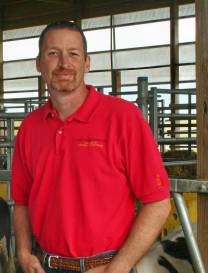AMES, Iowa – Veterinarians at Iowa State University are using advanced forensic techniques and the same technology used by crime scene investigators to monitor drug residues in milk and meat.
The ISU researchers work with other veterinarians and producers to strengthen food safety and make sure animals are medicated properly.
“It’s the same instrumentation used for forensics testing in humans,” said Hans Coetzee, a professor of veterinary diagnostic and production animal medicine. “But we use it to test for drugs in animals.”
Coetzee leads the Pharmacology Analytical Support Team (PhAST) in the ISU Veterinary Diagnostic Laboratory. He and his team employ liquid chromatography mass spectrometry, an analytical chemistry technique commonly used in human pharmacology, to test dozens of milk and animal feed samples every month.
The team’s mission is to help local veterinarians and farmers make sure the meat and milk they produce satisfy FDA regulations governing the use of antibiotics and are safe for human consumption.
Growing awareness
Patrick Gorden, a senior clinician in veterinary diagnostic and production animal medicine, said the use of antibiotics in production animals has taken on greater importance as consumer awareness of food safety has grown in recent years.
Gorden said the use of antibiotics and other medications in production animals may lead to the possibility of violative levels of the medications being present when the milk and meat are offered for sale. In most cases, that happens because of mistakes in record keeping or animal handling, he said.
“It’s important to realize that mistakes can happen and that safeguards are in place to prevent those contaminated products from reaching the consumer,” Gorden said.
Gorden works with veterinarians, producers and inspectors to keep everyone up to date on the latest regulations and federal programs, developing educational materials and holding meetings across the state.
“Meat and milk are safe to consume, and the monitoring process is being continuously improved,” Gorden said.
Every load of milk is tested for the presence of medicines at or above FDA limits before it’s unloaded and processed. Of all milk tankers tested nationwide between October 2012 and September 2013, only 0.014 percent showed antibiotic levels above FDA limits.
All milk found to contain medicines above FDA limits is removed from the supply and destroyed, Gorden said.
From racehorses to milk samples
The PhAST laboratory started out in the 1980s testing racehorses for illegal substances. The lab still does testing for horse and dog racing, but its mission has shifted toward testing milk and feed samples for drug residues in the last few years, which requires the same sort of equipment and expertise as testing for racetracks, Coetzee said. The team tests around 50 milk samples and 100 feed samples in an average month, he said.
The samples are sent to the lab from local veterinarians for several reasons, Coetzee said. For instance, a veterinarian may suspect that a dairy cow was mistakenly given an incorrect medication. Milk samples from the cow would be frozen and sent overnight to the lab, where PhAST personnel use chemical extraction techniques to strip away the fats and proteins from the milk, leaving only the drug signature.
It’s the only veterinary diagnostic lab in the United States that offers such clinical pharmacology services, so the lab has attracted clients from across the country. And the PhAST team is expanding its services to include testing for oral fluids from pigs, a move supported by a grant from the National Pork Board.
“It’s unique in terms of the services commonly offered by veterinary diagnostic labs,” Coetzee said.

